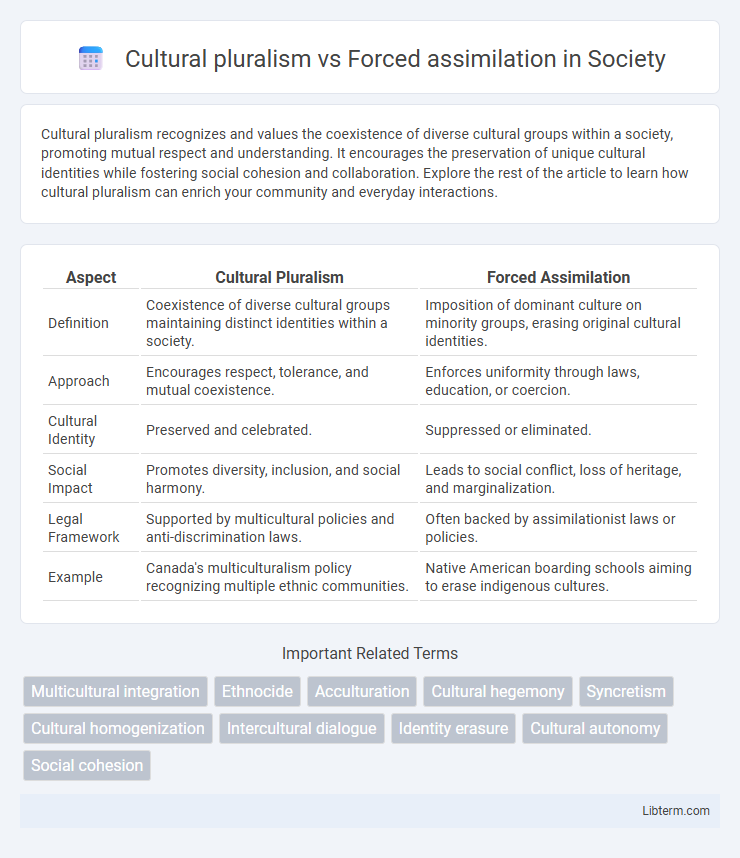Cultural pluralism recognizes and values the coexistence of diverse cultural groups within a society, promoting mutual respect and understanding. It encourages the preservation of unique cultural identities while fostering social cohesion and collaboration. Explore the rest of the article to learn how cultural pluralism can enrich your community and everyday interactions.
Table of Comparison
| Aspect | Cultural Pluralism | Forced Assimilation |
|---|---|---|
| Definition | Coexistence of diverse cultural groups maintaining distinct identities within a society. | Imposition of dominant culture on minority groups, erasing original cultural identities. |
| Approach | Encourages respect, tolerance, and mutual coexistence. | Enforces uniformity through laws, education, or coercion. |
| Cultural Identity | Preserved and celebrated. | Suppressed or eliminated. |
| Social Impact | Promotes diversity, inclusion, and social harmony. | Leads to social conflict, loss of heritage, and marginalization. |
| Legal Framework | Supported by multicultural policies and anti-discrimination laws. | Often backed by assimilationist laws or policies. |
| Example | Canada's multiculturalism policy recognizing multiple ethnic communities. | Native American boarding schools aiming to erase indigenous cultures. |
Understanding Cultural Pluralism
Cultural pluralism emphasizes preserving diverse cultural identities within a society, allowing multiple ethnic groups to coexist and maintain their unique traditions and languages. Understanding cultural pluralism involves recognizing and valuing the contributions of different cultural communities to social cohesion and mutual respect. This approach contrasts sharply with forced assimilation, which seeks to erase cultural differences by pressuring minority groups to conform to the dominant culture's norms.
Defining Forced Assimilation
Forced assimilation is the process by which a dominant group imposes its language, customs, and values on minority groups, often through coercive measures such as laws, education policies, and social pressure. This practice undermines cultural pluralism by erasing distinct cultural identities and enforcing uniformity within a society. Historical examples include the forced assimilation of Indigenous populations through boarding schools and language prohibitions.
Historical Contexts of Cultural Pluralism
Cultural pluralism historically emerged as a response to the failure of forced assimilation policies in diverse societies, emphasizing the coexistence of multiple cultural identities within a single political framework. In the late 19th and early 20th centuries, constitutional democracies such as the United States and Canada gradually shifted from forced assimilation of Native Americans and immigrant groups toward recognition of cultural pluralism to promote social harmony and political stability. Ethnographic studies and civil rights movements during the mid-20th century further reinforced cultural pluralism as a model celebrating linguistic, religious, and ethnic diversity, contrasting sharply with earlier assimilationist approaches that sought to homogenize minority populations.
Major Examples of Forced Assimilation
Major examples of forced assimilation include the Native American boarding schools in the United States, where Indigenous children were compelled to abandon their languages and customs to adopt Euro-American culture. The Australian government's Stolen Generations policy forcibly removed Aboriginal children from their families to integrate them into white society. In Canada, the residential school system systematically suppressed Indigenous identities through enforced cultural assimilation and linguistic erasure.
Benefits of Cultural Pluralism in Society
Cultural pluralism promotes social harmony by encouraging diverse ethnic groups to maintain their unique traditions and languages, fostering mutual respect and understanding. It enhances creativity and innovation through the blending of different perspectives and experiences within a community. Societies embracing cultural pluralism tend to experience greater social cohesion and reduced ethnic conflicts compared to those enforcing forced assimilation.
Consequences of Forced Assimilation
Forced assimilation often results in the erosion of indigenous languages, traditions, and cultural identities, leading to the loss of heritage and community cohesion. Psychological effects include trauma, identity confusion, and intergenerational distrust within affected populations. These consequences undermine social diversity and contribute to systemic marginalization and inequality.
Government Policies and Their Impact
Government policies promoting cultural pluralism endorse the protection of ethnic diversity through legal frameworks supporting language rights, religious freedom, and equitable political representation, fostering social cohesion and minority empowerment. In contrast, forced assimilation policies impose dominant cultural norms via compulsory education, language suppression, and restrictions on traditional practices, often resulting in cultural erosion and social alienation. The long-term impact of such assimilationist measures includes loss of cultural heritage and increased marginalization, while pluralistic policies contribute to multicultural stability and enhanced group identity preservation.
Social Cohesion vs Cultural Identity
Cultural pluralism promotes social cohesion by valuing diverse cultural identities and encouraging mutual respect within society, allowing individuals to maintain their unique traditions while contributing to a harmonious community. Forced assimilation undermines cultural identity by compelling minority groups to abandon their heritage, often leading to social fragmentation and resentment. Emphasizing cultural pluralism fosters inclusivity and stronger social bonds, whereas forced assimilation risks eroding social cohesion through loss of cultural diversity.
Voices and Perspectives: Minority Experiences
Minority voices reveal that cultural pluralism fosters inclusion by validating diverse identities and preserving heritage, enhancing social cohesion and personal dignity. In contrast, forced assimilation often silences these perspectives, leading to loss of cultural identity, intergenerational trauma, and resistance movements. Studies show that embracing cultural pluralism improves mental health outcomes and community resilience among marginalized groups.
The Path Forward: Promoting Inclusion
Cultural pluralism fosters societal cohesion by valuing diverse cultural identities and encouraging mutual respect among different ethnic groups. Inclusive policies that support multilingual education, equitable representation, and community engagement create environments where cultural differences are celebrated rather than suppressed. Promoting inclusion through cultural pluralism enhances social harmony, reduces prejudice, and strengthens democratic participation in increasingly diverse societies.
Cultural pluralism Infographic

 libterm.com
libterm.com